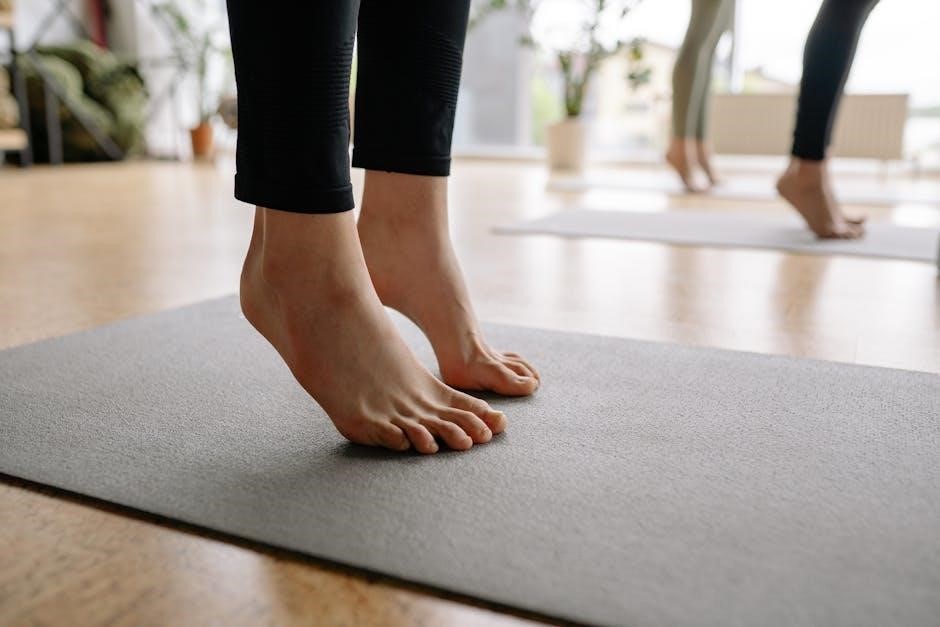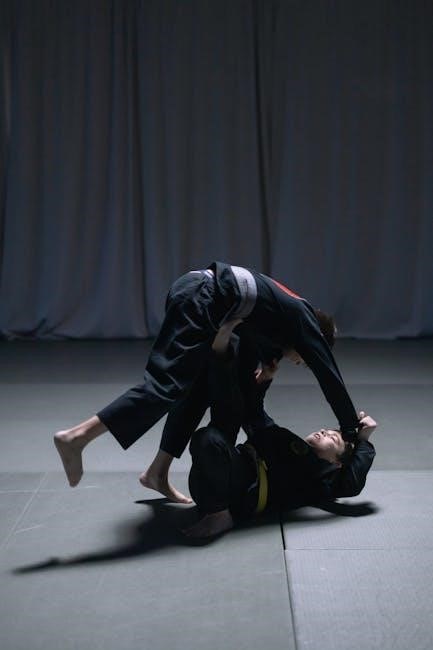The 5-4-3-2-1 grounding technique is a popular mindfulness exercise that helps individuals anchor themselves in the present moment by engaging their senses. It is often used to reduce anxiety and stress, offering a simple yet effective way to regain emotional balance. By systematically connecting with surroundings through sight, sound, touch, smell, and taste, this technique promotes calmness and clarity. Its versatility makes it accessible to anyone, regardless of their environment or emotional state.
1.1 Overview of the Technique
The 5-4-3-2-1 grounding technique is a mindfulness exercise designed to help individuals focus on the present moment. It involves systematically engaging the five senses to create a sense of calm and reduce anxiety. The technique is structured by identifying specific numbers of sensory experiences: 5 things seen, 4 things touched, 3 things heard, 2 things smelled, and 1 thing tasted. This process helps anchor the mind in reality, providing a practical tool for managing stress and emotional overwhelm in various situations.
1.2 Purpose and Benefits
The primary purpose of the 5-4-3-2-1 grounding technique is to help individuals anchor themselves in the present moment, reducing feelings of anxiety and stress. By focusing on sensory experiences, it distracts the mind from overwhelming thoughts. The technique benefits emotional well-being by promoting calmness, improving mindfulness, and enhancing focus. It is particularly useful in moments of panic or emotional overload, offering a quick and effective way to regain control and balance. Regular practice can lead to increased resilience and emotional stability.

How the 5-4-3-2-1 Grounding Technique Works
The 5-4-3-2-1 technique works by engaging the senses to ground oneself in the present. It systematically focuses on five things seen, four touched, three heard, two smelled, and one tasted. This structured approach shifts attention from distressing thoughts to tangible experiences, fostering mindfulness and emotional stability. By progressively connecting with the environment, it interrupts anxiety cycles, promoting immediate calm and clarity.
2.1 Engaging the Five Senses
The 5-4-3-2-1 technique engages the senses to anchor the mind in the present. Start by identifying five distinct things you can see, such as objects or colors. Next, notice four things you can touch, like textures or sensations. Then, listen for three sounds around you, focusing on their clarity. After that, detect two distinct smells, inhaling deeply. Finally, acknowledge one thing you can taste, savoring the flavor. This sequential process grounds the mind by connecting it to tangible experiences.
2.2 Step-by-Step Process
The 5-4-3-2-1 technique involves a structured approach to grounding. Begin by identifying five things you can see, such as objects or colors. Next, notice four things you can touch, like textures or sensations. Then, listen for three distinct sounds around you. After that, detect two things you can smell, inhaling deeply. Finally, acknowledge one thing you can taste, savoring the flavor. This sequential process helps anchor the mind in the present moment, reducing anxiety and promoting calmness. Each step engages a different sense, creating a holistic grounding experience.

Step-by-Step Guide to Practicing the Technique
This practical guide outlines a straightforward method to master the 5-4-3-2-1 grounding technique. By engaging each sense sequentially, users can effectively anchor themselves in the present moment, fostering calmness and clarity. The structured approach ensures ease of practice, making it accessible for anyone seeking to reduce anxiety and enhance mindfulness in daily life.
3.1 Identifying 5 Things You Can See
Begin by looking around you and naming five distinct objects you can see. This step encourages mindfulness and presence, helping you disconnect from anxious thoughts. Choose specific details, such as colors, shapes, or textures, to enhance focus. For example, notice the pattern on a rug, the shade of a wall, or the design of a nearby object. This visual grounding lays the foundation for engaging your other senses effectively.
3.2 Noticing 4 Things You Can Touch
Next, bring your attention to four things you can touch. This could be the texture of your clothing, the sensation of your feet on the ground, or the feel of an object nearby, like a chair or table. Focus on the physical sensations, such as warmth, softness, or firmness. This step deepens your connection to the present moment and further distracts from anxious thoughts, grounding you in tangible reality.
3.3 Recognizing 3 Things You Can Hear
Now, shift your focus to three things you can hear. These could be background noises, like a fan humming, birds chirping, or someone speaking. Pay attention to the volume, tone, and source of each sound. This step encourages intentional listening, helping you stay present and grounded. Even subtle sounds, like a clock ticking or your own breathing, count. The goal is to immerse yourself in the auditory details of your environment, enhancing your mindfulness and connection to the moment.
3.4 Detecting 2 Things You Can Smell
Next, identify two distinct smells in your environment. These could be subtle, like fresh air, or stronger, like food cooking. Focus on the scent’s origin and intensity. Engaging your sense of smell helps deepen your connection to the present moment. Even faint odors, such as a candle or a plant, count. This step encourages mindfulness and awareness, grounding you further in your surroundings while reducing mental distraction and fostering calmness.
3.5 Acknowledging 1 Thing You Can Taste
Finally, notice one thing you can taste, even if it’s subtle, like a hint of mint or the faint flavor of a recent drink. Focus on the sensation and origin of the taste. This step completes the grounding process by fully engaging your senses. It encourages mindfulness and presence, helping you feel more connected to your environment. The simplicity of this step reinforces the technique’s effectiveness in calming your mind and anchoring you in the moment.

Benefits of the 5-4-3-2-1 Grounding Technique
The 5-4-3-2-1 grounding technique offers numerous benefits, including reducing anxiety and stress, improving mindfulness, and providing a simple, effective way to stay present in any situation.
4.1 Reducing Anxiety and Stress
The 5-4-3-2-1 grounding technique is highly effective in reducing anxiety and stress by redirecting focus from overwhelming thoughts to the present moment. By engaging the senses, individuals can calm their minds and regain emotional balance. This method is particularly useful during panic attacks or stressful situations, providing a simple yet powerful tool to manage anxiety and restore a sense of control and calmness. Regular practice enhances its benefits, making it a valuable technique for mental well-being.
4.2 Improving Mindfulness and Presence
The 5-4-3-2-1 grounding technique enhances mindfulness by encouraging individuals to fully engage with their surroundings. By focusing on sensory details, it quiets the mind and enhances awareness of the present moment. This practice fosters a deeper connection to reality, helping to distractions and mental chatter. Regular use strengthens the ability to stay present, improving emotional regulation and overall mental clarity. It serves as a powerful tool for cultivating mindfulness in daily life.
Tips for Effective Practice
Start with small, manageable steps to build consistency. Practice regularly to enhance its benefits and make it a daily habit. Use sensory reminders to stay focused and grounded, ensuring a deeper connection to your surroundings. Incorporate the technique into daily activities for sustained mindfulness and emotional balance, fostering long-term well-being.
5.1 Starting with Small Steps
Begin by practicing the technique in short, manageable sessions to build familiarity and confidence. Start with identifying one sense at a time, gradually incorporating more as you become comfortable. For example, focus on listing five things you can see before moving on to sounds or textures. This incremental approach helps make the exercise feel less overwhelming, allowing you to develop the skill naturally. Consistency is key to mastering the technique and making it a reliable tool for grounding.
5.2 Incorporating the Technique into Daily Life
Integrate the 5-4-3-2-1 technique into your daily routine by practicing it during breaks, commutes, or stressful moments. Start your day with it to set a mindful tone or use it before bed to unwind. The portability of the exercise makes it easy to apply anywhere, helping you stay grounded and centered no matter the situation. Regular practice enhances its effectiveness, turning it into a reliable tool for maintaining emotional balance and reducing stress throughout the day.

Variations of the Grounding Technique
The 5-4-3-2-1 technique can be adapted by changing the order of senses or adjusting the number of items. Some variations include focusing on textures or combining it with breathing exercises for enhanced relaxation.
6.1 Adapting the Technique for Different Environments
The 5-4-3-2-1 technique is versatile and can be adapted to various environments. In a quiet room, focus on subtle sounds and textures. Outdoors, emphasize nature’s sights and smells. In busy settings, concentrate on grounding through touch and taste. Adjustments allow the practice to remain effective, ensuring it suits any location, making it a practical tool for maintaining calm and presence wherever you are, regardless of surroundings.
6.2 Combining with Other Relaxation Methods
The 5-4-3-2-1 grounding technique can be paired with other relaxation methods to enhance its effectiveness. For example, incorporating deep breathing or progressive muscle relaxation can deepen calmness. Combining it with mindfulness exercises, such as body scanning or meditation, further strengthens its grounding effects. This integration allows individuals to tailor their practice to personal preferences, creating a holistic approach to managing stress and promoting emotional balance in various situations.

Scientific Basis and Evidence
The 5-4-3-2-1 grounding technique is supported by studies on mindfulness and sensory grounding, which validate its effectiveness in reducing anxiety and stress through present-moment focus.
7;1 The Role of Mindfulness in Grounding
Mindfulness is central to grounding, fostering a non-judgmental awareness of the present. By focusing on sensory experiences, mindfulness helps individuals disengage from distressing thoughts, anchoring them in reality. This practice reduces anxiety by enhancing emotional regulation and promoting a sense of control. The 5-4-3-2-1 technique exemplifies mindfulness, guiding users to systematically engage their senses, thereby cultivating calm and clarity in stressful moments. Its effectiveness lies in its ability to redirect focus from internal turmoil to external stimuli, grounding the individual firmly in the now.
7.2 Research Supporting the Technique
Research consistently supports the 5-4-3-2-1 grounding technique as an effective tool for anxiety reduction and emotional regulation. Studies indicate that mindfulness-based interventions, like this method, significantly decrease stress levels and improve mental clarity. By engaging the senses, individuals redirect their focus from anxious thoughts to their immediate environment, fostering a sense of control and calm. This evidence-based approach is widely recommended by mental health professionals for its simplicity and proven efficacy in grounding individuals in the present moment.

Success Stories and Testimonials
Users report significant reductions in anxiety and improved emotional balance after practicing the 5-4-3-2-1 technique. Many share stories of feeling grounded and calm during stressful moments.
8.1 Real-Life Examples of the Technique’s Effectiveness
Individuals have shared how the 5-4-3-2-1 technique has helped them manage panic attacks, reduce workplace stress, and stay calm during public speaking. One user mentioned using it during a flight to alleviate anxiety, while another found it helpful in coping with crowded spaces. Many reported feeling more centered and able to focus on the present, highlighting its versatility in various stressful situations. These stories illustrate its practical and impactful benefits;
8.2 User Experiences and Feedback
Users consistently praise the 5-4-3-2-1 grounding technique for its simplicity and effectiveness. Many report feeling calmer and more centered after just one practice session. Feedback highlights its ease of use in various settings, from busy offices to quiet homes. Some users appreciate how it helps them regain control during panic attacks, while others value its ability to enhance mindfulness. Overall, the technique is widely regarded as a practical tool for managing stress and improving emotional well-being in daily life.
The 5-4-3-2-1 grounding technique is a powerful tool for reducing anxiety and fostering mindfulness. Its simplicity and effectiveness make it accessible to everyone, promoting emotional well-being and calmness in daily life. Give it a try and experience the transformative impact it can have on your mental health.
9.1 Recap of the Technique’s Importance
The 5-4-3-2-1 grounding technique is a simple yet profound method for reducing anxiety and stress by anchoring oneself in the present. By engaging the five senses, it helps individuals regain emotional balance and clarity. Its accessibility and effectiveness make it a valuable tool for anyone seeking mindfulness and calmness in overwhelming situations. This technique’s widespread use underscores its importance in promoting mental well-being and self-care in daily life.
9.2 Encouragement to Try the Technique
Give the 5-4-3-2-1 grounding technique a try—it’s a simple, effective way to calm your mind and connect with your surroundings. Easy to learn and practice anywhere, it offers a powerful tool for mindfulness and stress relief. Whether you’re feeling overwhelmed or seeking a moment of clarity, this technique can help you regain control and find peace. Take the first step today and discover how it can positively impact your mental well-being and daily life.



